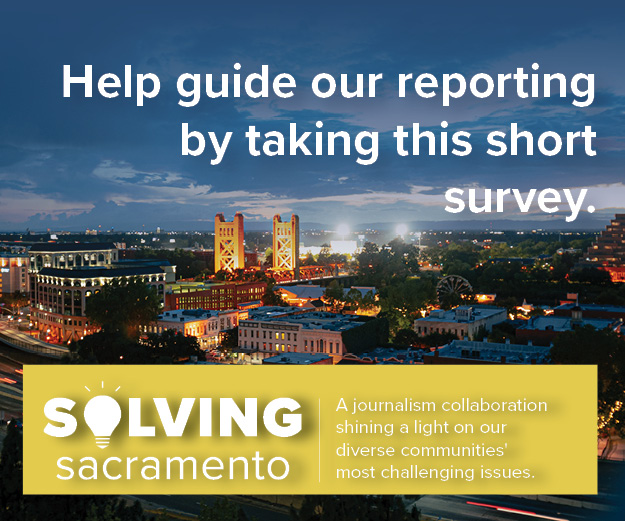By Graham Womack
Kendra Lewis is at a crossroads. Lewis, who became executive director of the Sacramento Housing Alliance in early 2020, announced recently that she would be leaving to take a position with Sierra Health Foundation.
Lewis recently spoke with us to discuss the work she’s done with SHA and the current state of affordable housing in the Sacramento region.
Tell me about the work of SHA and how it relates to California’s housing crisis and the need for more affordable housing in the Sacramento region.
The Sacramento Housing Alliance was founded in 1989, by a group of really dynamic … people in affordable housing, at the nonprofit level, at the state level and some in the private sector, and just to really help shape policy for affordable housing in the Sacramento region.
Organizations like SHA are pretty much throughout the state. … We have members, individual members and organizational members that come together with us to really try to shape and frame what the needs are, what their needs are, and then we have a very strong racial and social justice component to the work that we do.
You mentioned the diversity component. Sacramento historically has a serious legacy of redlining, which officially stopped being policy in the ‘60s. Do you see things getting better on that front?
I see this is the beginning of the end of it, in a sense, because of the new zoning with single-family zoning. … Sacramento was one of the first cities to actually vote and change the ordinance. We were the first in the state, one of only two or three in the country. And there was very little opposition to it.
I think more and more people don’t see affordable housing projects in their community as a threat, as they used to.
The NIMBYs seem like they have less power these days.
Yeah. They use that name, but it’s masking the same issues from that era [when] it was very easy just to say, ‘No, we don’t want you to be here.’
I guess I say it this way — it’s really not kosher — but I think people understand more and more, it really comes down to two things. There’s the NIMBYs that are flat-out just … prejudiced. They’re not yielding. And then there are people who I think have some environmental and other concerns, architectural concerns, and they tend to … come to a consensus far [more] often than the others.
What do you see as the major factors driving the housing crisis in the Sacramento region?
The factor is not land. It’s money. And NIMBYism for sure, we saw what just happened in Elk Grove. That was nimbyism on steroids.
I would say that SHA is really good at, and fighting for, more resources to tackle the fundamental issues at the state level. When our affordable housing builders have a project, they have to compete with LA, San Diego and San Francisco for the same amount of money in the same way — and a lot of the resources are not here, as they are in LA and the Bay Area and so on. So we lose out in getting funding in that sense.
We really work hard to make sure Sacramento is not overlooked when it comes to the barriers. All things would be equal, Sacramento probably would be in the lead because we have more land than most of those areas available to build.
When you talk about money, are you talking more about the cost to build or the cost for prospective homeowners or renters to be able to get inside of a property?
For permanent affordable housing … it’s really money. … Because for-profit builders can build, they basically put their profit in the rent. Affordable housing builders can’t do that. So they have to find other monies, diverse monies, and it’s either coming from the state or there’s local money that comes from bonds or measures and Sacramento just hasn’t had that … flow, like a lot of the other cities do.
At the state level, we really advocate for more equity as it relates to the process and applying for housing for our builders, more money, of course at the state level. Locally, we’re really focused on some way to have some permanent pathway consistently … to pay for more affordable housing. We have to have a flow of money that is consistent and permanent.
What do you see as the most critical solutions to the lack of affordable housing?
Inclusionary helps. The good news is there are more projects in our region, more than ever before. So that’s good. There’s a lot more investment in that sense.
Looking at the county, one of the fundamental issues with Sacramento County, the county has not done close to what its obligation is to the issue around affordable housing and homelessness, and that’s a huge issue.
When you look at all the money that came from the state and the feds to Sacramento, the county doesn’t have a plan. You can’t solve the region’s problem when Sacramento is doing its share, Elk Grove is doing its share, Rancho Cordova, Folsom, Placer, and then you have the county that just was like, ‘No way.’
You’re referring to the Regional Housing Needs Allocation obligations?
Yes. The RHNA budget. One of the issues with Measure O was really tied to the fact that this measure was placed on the ballot by members of the Sacramento [Metropolitan] Chamber and builder community folks, one, without a plan, two, without really speaking to the organizations that do this every day.
But the crisis in the resources are in the county budget, not the city budget. So you created all this other additional chaos now and extra funds because there’s probably going to be lawsuits should it absolutely pass because the county does not have a plan … and you’d think that after this came up, they’d have one. Now they’re working on something, but nobody’s seen it. [Editor’s note: City and county officials approved a partnership agreement related to homelessness after Lewis spoke to Solving Sacramento.]
When it comes to promising affordable housing strategies, tell me more about why they offer the most potential to solve the problem of housing affordability?
What we’re enthusiastic about is the fact that there is definitely a political will in the region. The housing element process we just went through gives us hope it’s a follow through. But I would say the thing we’re most excited about is that it is not tucked away as a secondary issue. It is a primary No. 1 issue.
Is Proposition 13 one of the big reasons we’ve gotten to the point we’re at with housing being so impacted in California?
No, it’s single zoning, and it’s Article 34.
That’s at the state level, right?
It’s Constitutional. It’s a Jim Crow relic and it is basically why every single city and county in California has to do a workaround. Because legally and technically, any affordable housing projects would have to go to a local vote. And that’s just pure, old racism. And it’s unconstitutional. Article 34 is the only thing of its kind in the country. No other state has it. It’s ridiculous. If you asked five people about Article 34 … they would not know what Article 34 is.
Is there any evidence or data that demonstrates the effectiveness of some of the housing solutions you’ve been talking about?
If you look at it the way SHA has looked at it, if you look at those that are in permanent, affordable housing — meaning they only have to pay 30 percent of their income — almost 99.9 percent of those residents [are] not vulnerable to being homeless. Even in the pandemic, if they lost their jobs, had a little insecurity, affordable housing wherever they live protects them.
What is the cost of when somebody is on the street versus keeping them off the street? That’s how we look at affordable housing: the cost to the public. To get people off the street, once they’re on, it’s far more expensive than it is to prevent them.
So when people talk about how expensive affordable housing is to build — and they tried to use that as an excuse to discount it — when you think about what the cost of human beings being on the street, once they’re there, their mental health costs and everything else, it is far more expensive and really inhumane in the long-term for people to be out on the street as long as as they end up being there, because we don’t have enough affordable housing.
You have all of these vulnerable populations and not enough inventory. Our argument and our data is you keep people off the streets, and you can deal with this crisis. Nobody wants to see all the folks in tents and whatnot. There’s a whole other shadowy population we aren’t even dealing with living in the day. We’re saying affordable housing keeps people off the streets.
What limitations do you see when it comes to some of the most effective strategies for creating affordable housing?
It’s regulations, definitely. I think there’s an unwillingness to support affordable housing a lot of times because people think it takes too long. Sometimes it used to. I have seen, in my years at SHA, projects that move a lot faster.
I think that moving faster gives folks hope. … Because the other thing is people think, ‘You spent all this money, it takes 10 years, I don’t get to see a project in my lifetime.’ And I really think that because some of the regulations are actually getting moved out the way that these projects are moving and getting built out a lot faster.
The builders are really becoming more and more vocal about that. It costs more when it takes longer, right? But they’re like, ‘If you move this barrier, we can get this done. This isn’t a problem, we can get this done.’ And that’s happening more and more. … Some of that is at the state level, but a lot of it is local, too.
Are there things that can be done locally to deal with homelessnes?
The name of the game is local. I think the state level is where the roadblocks are. Because the money and just a lot of the issues are at the state level. … Mercy [Housing] here has had several projects in the last year, where there was some gap money, they needed some infrastructure built out, and that was all local, coming together locally to make that happen.
One of the things that SHA is a leading part of going into this next year is having a solid housing coalition. … On the local level, with this coalition, is really training people in organizations. Because every single nonprofit organization has an issue around housing now. If you do direct services for anybody, if you are doing any services, the No. 1 issue for their clients, people they serve, is housing.
That makes sense, especially for people who need permanent supportive housing.
Exactly. And then are you familiar with the CalAIM [California Advancing and Innovating Medi-Cal] program? It’s very dense and complicated. But as my mom would say, the nickel version of it is basically, it’s a program that was rolled out by the state. … One of the issues with affordable housing is services. They can build as many projects as they want, but when you’re dealing with people that are coming off the street, or those that have mental challenges, they need services in order to stay off the street.
CalAIM — and there’s now money actually in the budget — allows affordable housing builders and health care providers to work together to offer services. That’s an incredible program and we’ve been working in our region with Kaiser Health Net, Wellspring, Hope Cooperative who actually does the service providing, to really figure out what that looks like for us.
You’re coming up on the end of your tenure with SHA. Looking back on it, what are you most proud of?
It’s so bittersweet. I love this work. … I would say the hallmark project of what we did was Aggie Square. It was really a state and national hallmark for anti-displacement and anti-gentrification work, and then really calling in the resources and working. That project has become a model, in a lot of ways, in our region, and in the state.
I’m also proud of the fact that more and more of the everyday person in Sacramento knows about SHA and the work we do. Traditionally, only people in the bubble knew about the organization. Because of a lot of the work we do, and the people that we stood up for … most of the redline communities. I’m really proud about that.
What is the No. 1 piece of advice that you would give to somebody who comes in and does your job after you?
The advice I would give is the vision is this is a long-term game. It’s not a short-term game. But the small wins are big wins a lot of the time, especially for people who have historically been redlined and discriminated against.
It is not easy work. But I felt good, as tired as I am even now. I felt good every day I got to do that work. I’m really proud of all that we did and I hate that we just didn’t have enough time to do more. But you know, human beings only have so much.
This Q&A has been edited for length and clarity.
This story is part of the Solving Sacramento journalism collaborative. In 2022, we are focusing on finding solutions to the lack of affordable housing in the Sacramento region. Solving Sacramento is a project of the Local Media Foundation with support from the Solutions Journalism Network. Our partners include California Groundbreakers, Capital Public Radio, Outword, Russian America Media, Sacramento Business Journal, Sacramento News & Review, Sacramento Observer and Univision 19.




Be the first to comment on "Outgoing Sacramento Housing Alliance Executive Director Kendra Lewis on how affordable housing is now receiving the attention it deserves"